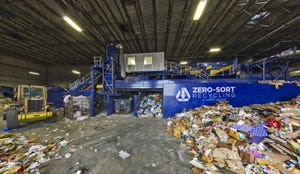What’s in Store for Landfill Gas-to-Energy Projects?
Operators are considering how to leverage the surplus they will have to capture.
Over the next five years more landfills will tap into opportunities to capitalize on the gas they generate, according to project industry experts. The trend will be driven largely by the updated federal New Source Performance Standard rules mandating lower greenhouse gas emissions from landfills. Operators are considering how to leverage the surplus they will have to capture.
Landfill gas to energy projects have been on the climb for years, with facilities in 48 states and one U.S. territory using landfill gas to produce electricity, heat, pipeline-quality gas or vehicle fuel. At least 60 commercial and industrial organizations have switched to LFG in their boilers.
More utilities are considering this resource to meet their renewable energy quotas, as spelled out in states’ renewable portfolio standards (RPS). And landfills themselves are capitalizing on the natural gas they generate. Collectively, these projects are saving money, reducing dependency on fossil fuel and curbing greenhouse gas emissions.
Technology is evolving but with a price tag.
In the past few years, technology to process the fuel has become more refined, though the most sophisticated systems are expensive. There has been an industry push to find cheaper, better ways to do the job, says Pat Sullivan, senior vice president of SCS Engineers in Sacramento, Calif.
In the meantime operators must scrutinize multiple factors to determine whether a project will pencil out—from fluctuating fossil fuel and electricity prices, to capital and operating costs to process a given fuel type.
“If you just want to burn gas in an [internal combustion] engine to make electricity, you may only need to remove moisture and compress gas,” Sullivan says. “A midlevel range option would leverage a gas turbine combustion device, which requires a little more processing, more gas compression and removal of impurities.
“But pipeline quality natural gas has to be 96 to 98 percent methane. Landfill gas starts at 40 to 55 percent methane,” he adds. “Generating pipeline quality calls for removing not only impurities, but carbon dioxide, nitrogen, oxygen and other constituents.” And this adds steps and expense.
Dealing with hydrogen sulfide is a top cost consideration
The industry is focused on finding cheaper, better ways to pull out impurities, particularly hydrogen sulfide, which damages combustion equipment and is one of the top cost considerations.
There are technologies like SULFATREAT, where carbon is impregnated with chemicals to facilitate its ability to remove sulfur.
The University of New Hampshire is using a rather sophisticated technology in its medium BTU project at the Turnkey Landfill in Rochester. It contracts with Waste Management for delivery of up to 5,000 standard cubic feet per minute of LFG, to generate electricity for the grid and the campus as well as for heated and chilled water.
The process entails using activated carbon to strip hydrogen sulfide. Volatile organic compounds and siloxanes are stripped. And then carbon dioxide is extracted. By stripping carbon dioxide, the system boosts methane content to 75 to 80 percent and translates to higher energy content per cubic foot.
UNH plans to pay off the project within 10 years, which will be mid-2018 and is on target to meet its goal, according to Dave Bowley, University of New Hampshire utilities systems manager.
“At one time, we were spending about $1 million a year to strip hydrogen sulfides,” says Bowley.
“But this new media we are using has twice the service life and greater absorption qualities,” he says. “So we recognize $300,00 to $400,000 in savings each year.”
But innovations don’t have to involve new technology; they can be new ways to leverage existing systems.
“It’s how the whole package is assembled, coupled with which technologies you select to remove constituents, in order to be cost effective and efficient,” says Sullivan.
It all comes back to economics and markets.
Whether landfills can make projects economically viable as they compete with cheap fossil fuels will depend largely on individual states—for instance whether they offer support such as subsidies or low-interest loans.
And it will depend on states RPS’s, which require utilities to meet specific levels of alternative, renewable fuels. Utilities could potentially become a breadbasket where states prioritize landfill gas among those alternatives.
“In some states, utilities may offer a premium on landfill gas to get renewable gas credit to meet their obligations,” says Brian Lips, project coordinator for the North Carolina Clean Energy Technology Center.
“Depending on specific rules around states’ RPS’s, a landfill gas project could earn a second income by selling renewable energy credits to the utility.”
About the Author
You May Also Like




